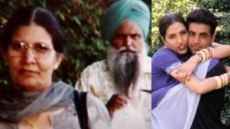CALGARY — The final paintings of Canadian figure-skating great Toller Cranston have returned home after his untimely death in Mexico more than a year ago.
Christopher Talbot, Cranston's longtime friend and agent, feels sadness despite successfully negotiating his way through months and months of red tape to retrieve dozens of pieces from Cranston's home in San Miguel de Allende.
"For the most part it's over. He's gone. There's no more paintings and I'm not sure what happens from here," said Talbot, president of Art Evolution Gallery and Lounge in Calgary.
"I miss him, painful as he was. It's so sad. It's spectacularly sad because you know it's the end."
Cranston, who was 65, was found dead from an apparent heart attack in his home in January 2015. The current display of his paintings will remain at the Calgary art gallery until April 20, which is Cranston's birthday.
He was a six-time Canadian senior men’s champion, and won bronze at the 1974 world championships and 1976 Olympics. While he never won an Olympic or world title, his dramatic showmanship on the ice presented a unique artistic vision that forever changed the sport.
Even while achieving uncommon acclaim as a figure skater, Cranston attended art school and pursued a career in art. After retiring from skating in 1997, he moved to Mexico, where art became his obsession.
Among the paintings at the gallery are two of Cranston's personal favourites. "The Contessas" are matching paintings of young women, wearing medieval garb, that hung in his bedroom.
Brightly coloured, fanciful themes are a trademark of Cranston's work. He once explained in an interview that his colourful compositions grew from an interest in Eastern influences at an unusually young age, specifically Russia, Ukraine, Uzbekistan, Pakistan and Turkestan.
"The inclination, the subject matter, the concepts, the sense of colour, the people, the worlds, the imagery — miraculously — was in evidence when I was six years of age,'' Cranston said.
Talbot said it's difficult to describe the late painter's style.
"There are hints of surrealism; there are hints of realism. In some of the paintings, there's a lot of cubism. You can't really nail it down," he said.
"He would take exotic things and he would take that influence and completely mix it up in his mind and put it on the canvas. Maybe it's Tollerism — something completely different."
One of Talbot's fondest memories was watching Cranston, who he estimates produced more than 20,000 paintings during his career, working in front of an easel.
"Disturbing Toller Cranston when he was painting, which was usually 12 hours a day, was akin to running a bull through the china shop. He did not welcome any kind of intrusion," he said with a smile.
"Having said that, I had lots of opportunity to sit quietly and just watch him paint, and it was like watching a magician. It was like watching something extraordinary to just see something come to life."
Talbot said Cranston was not a happy man, his only moments of joy coming when he was creating. That would end the minute he put his signature on the painting. He often never looked at the finished work again.
"He certainly suffered. Nothing was ever good enough, he was a perfectionist to the point of absolute dysfunction. The only thing this man was interested in was the next painting."
Talbot hopes Cranston is eventually recognized as the great Canadian artist that Talbot feels he became.
"He did everything for the art. This man lived, breathed and thought of nothing else but creating things. It was a solitary experience for him."





